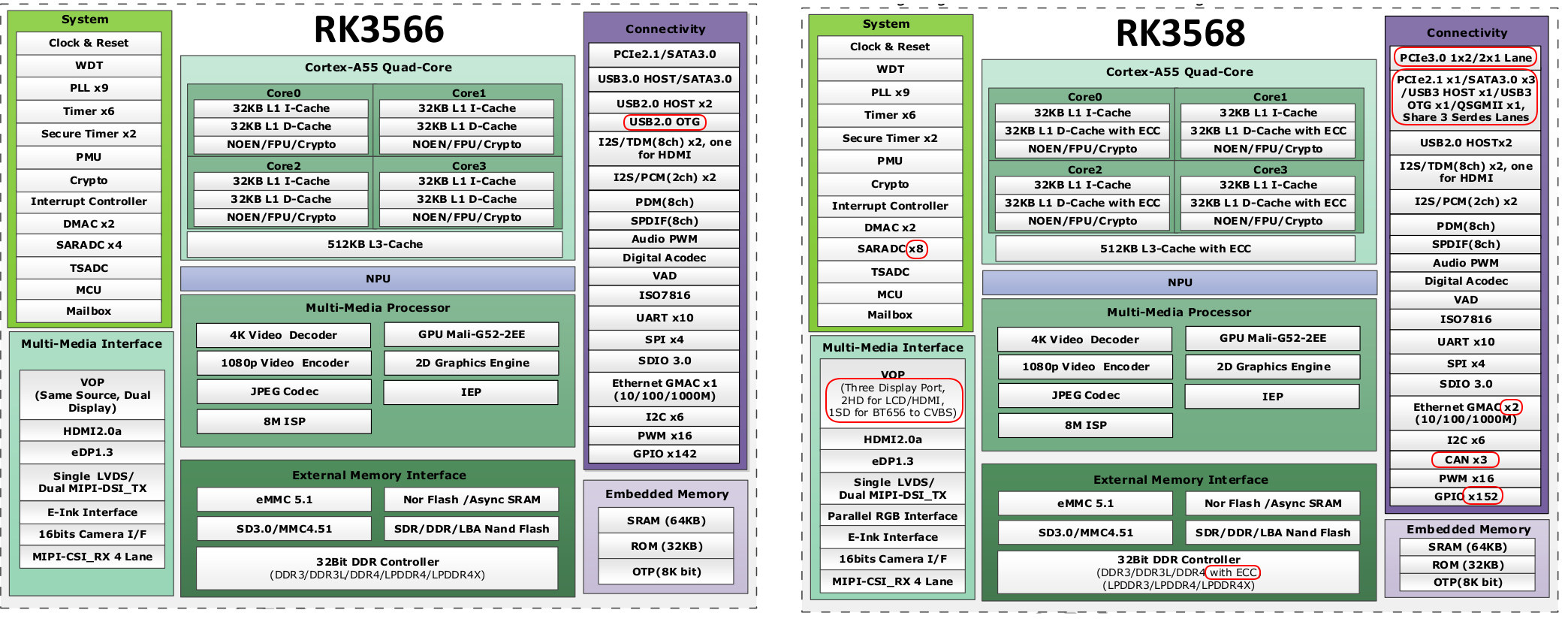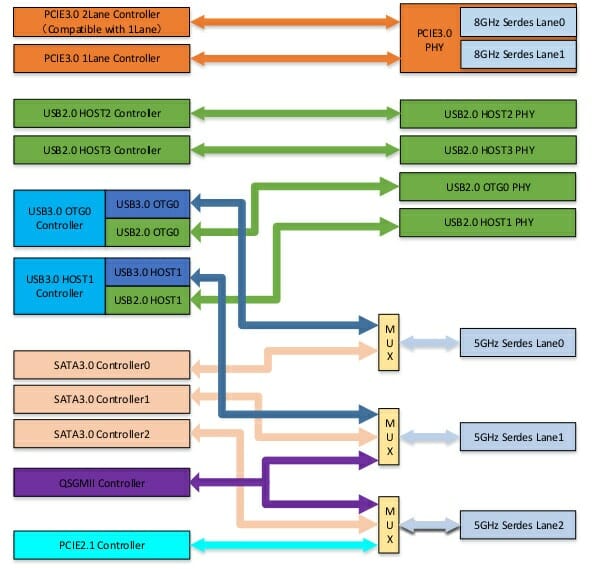We first covered Rockchip RK3566 processor in February, but we’ve been informed the specifications have changed since then, and earlier this month, we also wrote about RK3568 quad-core Cortex-A55 processor with the same base features but some extra I/Os.
But due to NDAs, people familiar with the chips could not release too many details, so we did not get the full picture. This has just changed as the datasheets for both processors have just dropped from somewhere here and there, and we can get a much closer look.
RK3566 and RK3568 specifications
 I’ve highlighted the obvious differences above, with the big ones being the PCIe interface and RK3568 having dual Gigabit Ethernet. The other features comparison can be found in the table below.
I’ve highlighted the obvious differences above, with the big ones being the PCIe interface and RK3568 having dual Gigabit Ethernet. The other features comparison can be found in the table below.
Rockchip RK3566 | Rockchip RK3568 |
|
|---|---|---|
| CPU | Quad-core Cortex-A55 |
|
| GPU | Mali-G52 EE |
|
| AI accelerator | 0.8 TOPS NPU |
|
| Memory | DDR3/DDR3L/DDR4 LPDDR3/LPDDR4/LPDDR4X | DDR3/DDR3L/DDR4 with ECC, LPDDR3/LPDDR4/LPDDR4X |
| Storage | NOR flash, SPI NAND, eMMC 5.1 , SATA 3.0, 8K OTP | NOR flash, SPI NAND, eMMC 5.1 , 3x SATA 3.0, 8K OTP |
| Display I/F | RGB, LVDS or MIPI DSI, HDMI 2.0a, eDP 1.3, e-Ink; dual-display support | RGB, LVDS or MIPI DSI, HDMI 2.0a, eDP 1.3, e-Ink; triple display support |
| VPU | Video decode – 4Kp60 H.264/H.265/VP9 Video encode – 1080p60 H.264/H.265 |
|
| Camera I/F | 8M ISP with HDR 4-lane / 2x 2-lane MIPI CSI2 @ 2.5 Gbps per lane 16-bit DVP camera support with BT.656/601/1120 |
|
| Audio | 8-channel I2S/TDM, 2x 2-channel I2S 8-channel PDM S/PDIF out |
|
| Networking | 1x Gigabit Ethernet (GMAC) | 2x Gigabit Ethernet (GMAC) Quad serial gigabit media-independent interface (QSGMII)* |
| USB | 2x USB 2.0 host, 1x USB 2.0 OTG, USB 3.0 host | 2x USB 2.0 host, USB 3.0/2.0 OTG, USB 3.0 host |
| PCIe | PCIe 2.1 1x1 lane | PCIe 2.1 1×1 lane PCIe 3.0 1×2 lane or 2x 1-lane @ 8 Gbps |
| Other I/Os | SDIO 3.0 10x UART, 4x SPI, 16x PWM, 6x I2C, 2x SARADC | SDIO 3.0 10x UART, 4x SPI, 16x PWM, 6x I2C, 3x CAN FD, 8x SARADC |
| Package | FCCSP565L (body: 15.5mm x 14.4mm; ball size: 0.3mm; ball pitch: 0.65 & 0.4mm) | FCBGA636L (body: 19mm x 19mm; ball size: 0.3mm; ball pitch: 0.65mm) |
Multiplexed interfaces.
Important note. Rockchip RK3566 and RK3568 are using Multi-PHY Interfaces, and while the table above lists all possible interfaces, they can not all be used at the same time. PCIe, SATA, USB 3.0 are multiplexed in most cases as shown in the diagram below for RK3568.

There are a fair amount of differences, and notably, both processors are not pin-to-pin compatible, so the upcoming Pine64 RK3566 SBC can not be easily upgraded to RK3568. People interested in ECC memory support will have to go with the latter, and so the ones wanting multiple SATA interfaces, PCIe 3.0 support, CAN bus, and/or dual Gigabit Ethernet.
Update: You can check our post about RK3566 benchmarks on Android 11 for more information about performance.

Jean-Luc started CNX Software in 2010 as a part-time endeavor, before quitting his job as a software engineering manager, and starting to write daily news, and reviews full time later in 2011.
Support CNX Software! Donate via cryptocurrencies, become a Patron on Patreon, or purchase goods on Amazon or Aliexpress




Is there no news about clock frequency? Or on what process node it’ll be made?
I hope they can keep the RK3566 passively cooled. Otherwise it would be no match for the S905x3/S905x4.
Mali-G52 is good. There’ll soon be good support for Bifrost. Could be a gaming champ.
I can’t wait to see new boards come out with this. It’s been too calm this year.
There are a bunch of frequencies in the datasheets, but they don’t explicitly mentions the core frequency.
However I can see the internal PLL has a VCO operating range of 475 to 1900 MHz. Its output clock frequency range is said to be 9 to 1900 MHz. I guess the 9MHz is for deep sleep?, and the VCO numbers are the actual frequency range.
The process node is 22nm.
btw, before comparing 22 to 12nm processes, you may want to read Arnd Bergmann (Arm LInux co-maintainer) comment @ https://www.cnx-software.com/2020/12/01/rockchip-rk3568-processor-to-power-edge-computing-and-nvr-applications/#comment-578856
Will all the IP on the SoC mean a very high price chip?
I don’t think it will be that expensive, but it won’t compete in price with the cheap TV box SoC’s like RK3328 or S905X3, etc… and that’s fine because it targets another segment of the market.
Actually it will occupy the room that was long reserved to Marvell. But since Marvell hasn’t done anything since their acquisition of Cavium, they’re leaving room for cheap competition, and that’s probably a good thing for consumers.
this one’s have much more I/O than amlogics SoCs.
The RK3568 does have much more I/O than S905x4. The RK3566 isn’t that different in I/O vs S905x4.
I think RK3568 is way more interesting for SBCs. Having PCIe 3.0 is a major advantage these days. I wonder how many makers will bother with the RK3566.
The PCIe 2.1 is probably for a wifi chip.
If the H6 would have had well implemented PCIe it would have made a big difference. Now it’s just another quad-core that overheats. I’m not waiting on another SoC like that. Cheers.
I think that the RK3566 will be attractive to those having done the porting work for the RK3568, and willing to offer scaled down versions of their products. It’s always easier to use the same set of development tools across several products than using for example S905x4 for the low-end and RK3568 for the middle end. But I agree that it’s unlikely that vendors will start with RK3566 given the current availability and performance of S905x4.
> it’s unlikely that vendors will start with RK3566 given the current availability and performance of S905x4
S905X4 has one PCIe lane muxed with USB3. You get either / or.
According to most recent block diagram above RK3566 has two high-speed buses that can be used in parallel: USB3 muxed with SATA and PCIe Gen2 muxed with another SATA. Probably the most interesting question with I/O in mind is whether RK356x’s SATA ports are PM capable and support FIS based switching.
RK3366 does have much more I/O than S905X4 since it can offer both usb3 & pcie 2.1 at the same time while these should be muxed inside the amlogic soc.
But in my opinion, these chips do not target the same market : i think of s905x4 as a very good tvbox soc (hardware av1 decoder + afbc) while the rk3566 is more versatile (8gb ram, npu, usb3 and pcie)
All the options of RK356* do indicate IMO that they are aimed outside TV box use, just comes down to how affordable is the SoC.
The RK3568 is a high bandwidth IoT router and the RK3566 is a lower priced IoT device.
Both with a focus to network NVR but also could make NAS.
The NPU & GPU as co-processors gives some interesting applications for both VisionAI & VoiceAI.
Its not a ‘gaming’ SoC at all with maybe the S905xx having pref for that.
I have been having a look at the Radxa offerings and with such a great combination of Muxes the 2 serdes buses provide its confusing to why they have made another Rockpi4 and again in PicoItx + 1Gbe as wow we could of had a $60-70 5gbe PCIe 3.0 x 2 router.
Or native 3x Sata with 2x PCIe 3.0 x1 M.2
I guess we will have to see what other suppliers provide but feel certain compelling opportunities have been missed with the RK3568 as a network router / co-ordinator.
AV1??
Probably only in the RK3588. Which is one reason why I’m waiting for that.
No AV1. Here’s the full list of supported codec from the datasheet:
Sounds very interesting
Please, a 64b ddr controller for the next one
Geekbench 4 RK3566
https://browser.geekbench.com/v4/cpu/15920516
Reminder of rk3568
https://browser.geekbench.com/v4/cpu/15873149
The computing power seems to be ~15% lower than S905X3(12nm) on the Odroid-C4.
https://browser.geekbench.com/v4/cpu/15949977
You can’t compare the total scores right now. AES instructions are not enabled yet in RK3566/RK3568 scores, or just compare individual tests like LZMA, JPEG, etc…
I can also see RK3568 is clocked @ 1.80 GHz, and RK3566 @ 1.99 GHz. We still don’t know the final frequency that will be used with those processors…
But LZMA, JPEG and some other stuff are still slightly slower than S905x3 even with a 1.99Ghz clocked RK3566.
Anyway, let’t compare the performance again once the AES feature is enabled and they finalize the clock frequency.
> slightly slower than S905x3 even with a 1.99Ghz clocked RK3566
You try to compare SoCs while Geekbench lists single limited benchmark runs of individual devices (that differ not only by SoC but also by DRAM access which involves both hardware and software –> bus width, clocks and DRAM initialisation/training).
Also Geekbench does not check whether the CPU cores really clock at the frequencies it reports, it simply parses some sysfs nodes.
No it’s not. It’s just moronic to stare at combined Geekbench scores especially when an outdated benchmark version is used and preliminary/pre-production settings on the devices in question are in use.
https://www.cnx-software.com/2020/12/01/rockchip-rk3568-processor-to-power-edge-computing-and-nvr-applications/#comment-578846